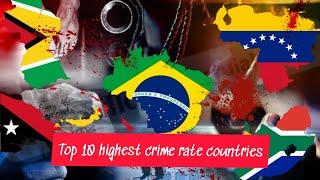Top 10 African Countries With the Highest Literacy Rate
Description
Top 10 African Countries with The Highest Literacy Rate
Welcome back to Displore and thanks for watching. In this video we shall be counting down the African countries with the highest literacy rate. Literacy is a critical piece of individual progress, social development, and economic health. Having the ability to read and write provides more educational and employment opportunities to the population, allowing people to increase their household incomes and bring their family out of low-income conditions. This skill has also been tied to improved public health conditions and increased political participation. Adult and youth education have increased over the years but however, a quarter of youth across the world still lackbasic literacy skills as indicated by data from the UNESCO Institute for Statistics. The data also showed that Sub-Saharan Africa and North Africa has 27% and 9% of the world’s illiterate population respectively. The good news is that Africa literacy levels have risen tremendously as compared to 50 years ago. In recent years, the youth have a higher literacy level at 91 percent than adults at 78 percent. As a whole, the global literacy rate is quite high. The literacy rate for all males and females at least 15 years oldis 86.3%. Males aged 15 and over have a literacy rate of 90%, while females lag behind at just 82.7%. Developed nations as a whole have a literacy rate of 99.2%.
If you are new here, welcome. Be sure to subscribe and turn on notification so that you don’t miss any of our daily uploads.
In Africa, there are many countries that have a very high literacy rate. The data on these countries were collected by UNESCO and World Population Review who were able to put together statistics pertaining to the literacy rates of all countries in the world. Of all the African countries reviewed, some stood out with exceptional literacy rates, hence here are the top 10 African countries with the highest literacy rates.
10. Namibia 81.90% of The Population
Namibia, officially the Republic of Namibia, is a country in southern Africa bordered by the Atlantic Ocean, Angola, Zambia, Botswana, and South Africa. In 2020, Namibia has an estimated population of 2.54 million.The current 81.90% literacy rate in Namibia reflects significant drop over previous years. For example, this number was at 89.4% in 2011, 76.5% in 2007 and most recently in 2018, it was at 91%. But Namibia still ranks as one of the top 10 African countries with the highest literacy rate due to the success of the National Literacy Program, which is administered by the Ministry of Education. Additionally, the government of Namibia has increased its educational expenditures and as of 2013, allocating 29% of the federal budget to public education. We hope that the numbers pick up again in the years to come.
9. Gabon 83.20% of the Population
Gabon, officially the Gabonese Republic, is a sovereign state on the west coast of Central Africa, bordered by the Republic of the Congo, Cameroon, Equatorial Guinea, and the Gulf of Guinea. Gabon has a population estimated at 2.23 million in 2020 and a total area of almost 270,000 square kilometers with a population density of around 5.5 people per square kilometer.Modeled on the French education system, Gabon’s education system is compulsory for those age 6 to 16, though the majority of students stay in school until the age of 19. Nearly 10 percent of the national budget is directed towards education, and the sole language of instruction is French, the language of the country’s former colonial ruler. Bantu languages may be studied as electives in secondary and higher levels. All this has attributed to Gabon staying at the top 10 of African countries with the highest literacy rates.
8. Burundi 85.60% Of the Population
Burundi, officially the Republic of Burundi, is a landlocked country in Southeast Africa, bordered by Tanzania, the Democratic Republic of the Congo and Rwanda. Despite being one of the poorest and hungriest countries in the world, Burundi's population has grown rapidly and as of 2020, the population is estimated at 11.89 million.Burundi enforces compulsory education for citizens between ages 7 and 13, and the government covers the bulk of costs through grade six. More education resources are allocated to the south and central regions of Burundi, however, and females historically have had fewer opportunities for primary or secondary schooling. The education system in Burundi suffered du





















Comments